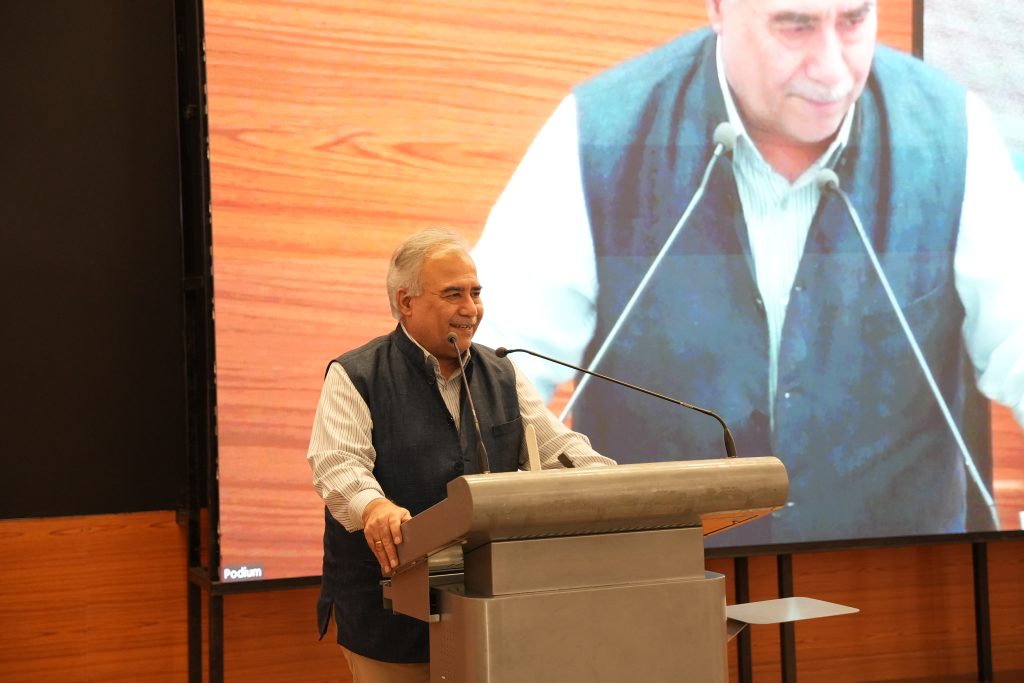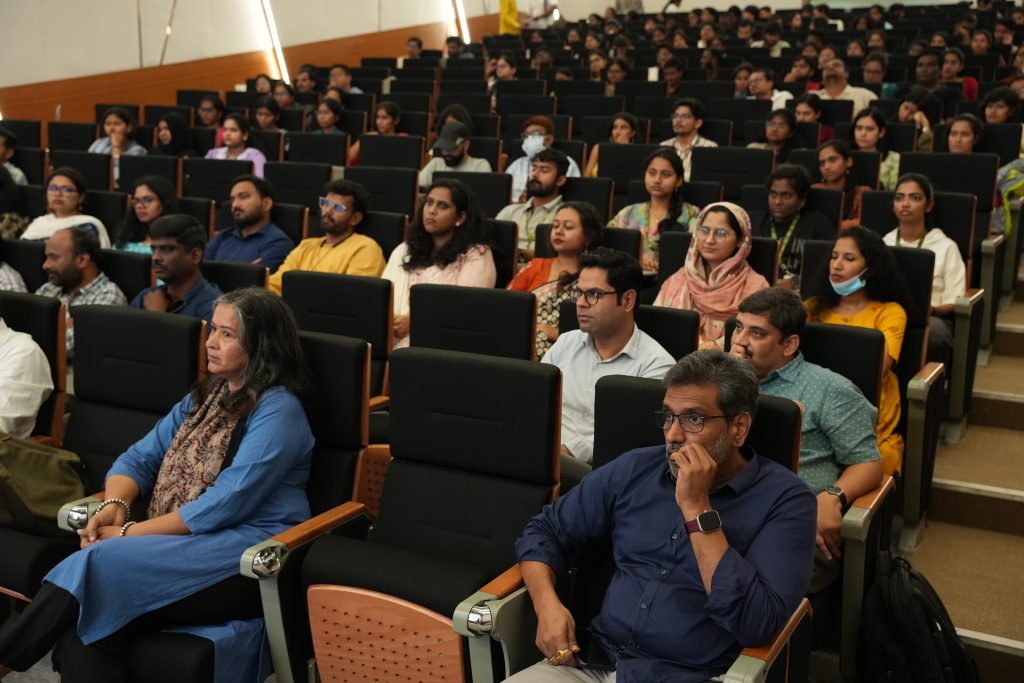Padmashri Prof. Shanti Sinha Discuss Child Labour and Child Rights in India at UDL#20
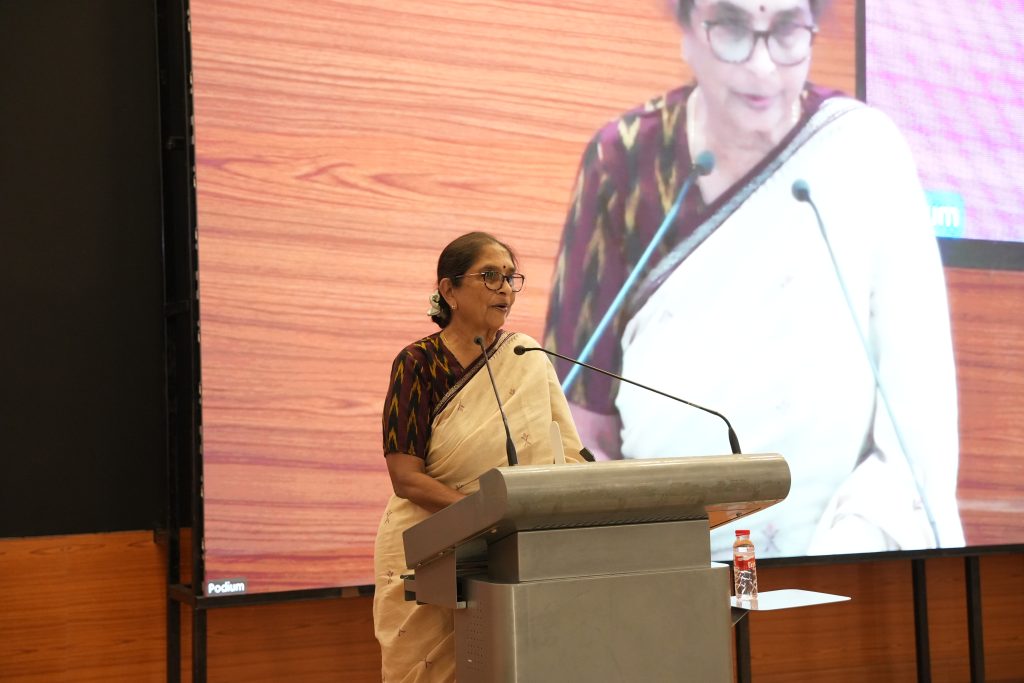
“Every Child Out of School is in Child Labour. Education, Education and Education alone is the Way Forward for a Progressing India.” – Prof. Shanti Sinha
The twentieth edition of the University Distinguished Lecture (UDL) on February 21, 2025, witnessed an invigorating session by the eminent anti-child labour activist Padma Shri Prof. Shanta Sinha, Ramon Magsaysay Awardee, Former Chairperson of the National Commission for Protection of Child Rights (NCPCR), and Professor (Retd.) Dept. of Political Science, Hyderabad Central University. The session on the topic “Making Education a Reality and Ending Child Labour: Experience of M.V. Foundation” gave an overview of the work of M.V. Foundation in the field of child rights in India.
In a society ravaged by poverty, where children were forced to join the bonded labour workforce, Prof. Sinha remarked that it was not poverty that led to child labour but child labour that led to poverty. Prof. Sinha elucidated on the non-negotiable principle adopted by the M.V. Foundation, that ‘no child must work, and every child must attend full-time formal day school,’ which broke the societal norms of Indian society.
She briefly spoke about the impact that the M.V. Foundation had and the ripple it created in the field of child rights. “M.V. Foundation has withdrawn over 15 lakh children in the age group of 5-14 years from child labour; stopped over 20,000 child marriages and pioneered a program for mainstreaming children to schools through residential bridge courses. The MVF’s mission to abolish child labour also led to the Closure of Night Schools and the creation of necessary amendments in the Child Labour Act of 1986,” stated Prof. Sinha.
The session also discussed Prof. Sinha’s Journey at the National Commission for Protection of Child Rights (NCPCR), and the various challenges faced in addressing key issues such as violation of children’s rights in relation to child labour and child trafficking, rights of children in areas of civil unrest, juvenile justice system, corporal punishment, child abuse and violence on children, and child malnutrition.
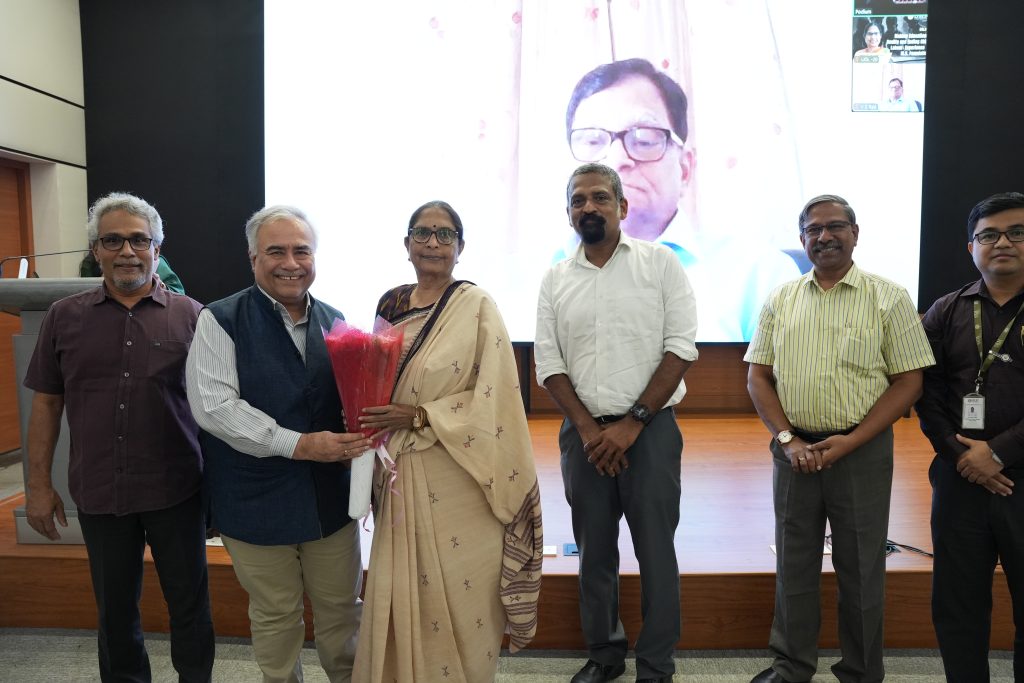
The UDL 20 was a mind opener and a lens into the reality of child labour still prevalent in India. Prof. Manoj K Arora, Vice Chancellor of SRM University-AP, expressed his gratitude to have the presence of a torchbearer of social reform at the UDL. He stated, “Prof. Sinha is a stalwart whose work has created a magnitudinal shift in the societal norm, significantly contributing to the abolition of child labour in India. We are grateful to imbibe from her knowledge and experience as a social leader.” Dean of Easwari School of Liberal Arts, Prof. Vishnupad, also expressed his heartfelt appreciation for Prof. Sinha’s presence and her work. He stated that the thought-provoking and inspiring session will ignite students to think in a ‘non-conventional’ way and offer courage to make a change.
The 20th UDL was organised under the aegis of the Office of Dean-Research, the UDL committee, and the Easwari School of Liberal Arts. It witnessed the presence of Registrar Dr R Premkumar, Dean of the School of Engineering and Sciences, Prof C V Tomy, Dean of Research, Prof. Ranjit Thapa, and Faculty and students of the varsity. The signature lecture series is the university’s flagship initiative to impart global exposure and quality education to its students.
- Published in Departmental News, History Current Happenings, News, Research News, University Distinguished Lecture
Paari School of Business Launch Two New B.Com. Specialisations
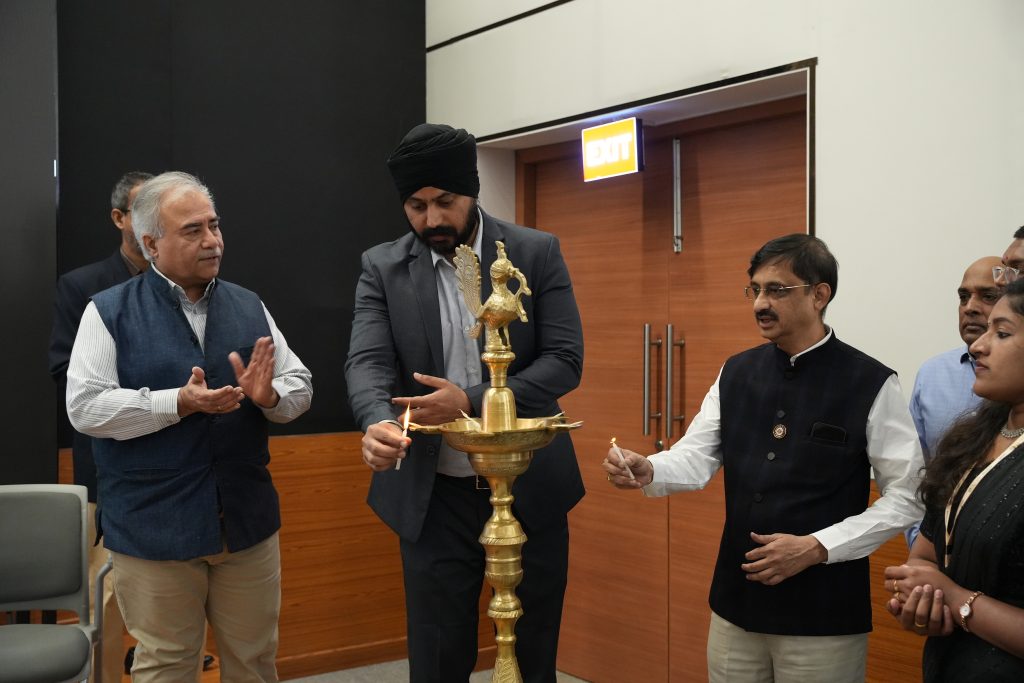
Marking a significant stride towards expanding academic offerings and equipping students with the skills required for the evolving business landscape, The Paari School of Business at SRM University-AP has launched two new specialisations for its B.Com. programme – B.Com. (CA Integrated) and B.Com. (Fintech and Banking).
The event witnessed the presence of stalwarts from Banking, Data Analytics and Chartered Accountancy along with the Vice Chancellor of SRM University-AP, Prof. Manoj K Arora, Registrar Dr R Premkumar, Dean-Paari School of Business, Prof. Bharadhwaj Sivakumaran, Head-Department of Commerce Dr A Lakshmana Rao, faculty, staff and students from the school. Mr Ruhbir Singh, CEO of Tatvic, a Global Analytics Firm, was the Chief Guest; Mr Bala Iyer, MD of Barclays Bank, was the Guest of Honour, and CA Ravi Kishore, President of ICAI Vijayawada Branch, was the Keynote Speaker.
Vice Chancellor Prof. Manoj K Arora appreciated the school for its launch of specialisations that will generously benefit the management education offered at the university. Dean Prof. Bharadhwaj briefly spoke on the objective of launching the two new specialisations and the expected outcome of the B.Com. programme. “At Paari School of Business, we offer modern, contemporary, and cutting-edge programmes that meaningfully align with current market demands. The curriculum of the two new specialisations is tightly integrated with the Fintech and CA fields and will be taught by industry experts and seasoned professionals,” stated Prof. Bharadhwaj in his welcome address.
This initiative by the Paari School of Business invokes innovation, inspiration, and excellence. In his address, Mr Ruhbir Singh, a pioneer in Digital Marketing and Data Analytics, elucidated the strategies for making it big in the business frontier. He remarked, “Critical thinking, keeping abreast with technology, and learning to present yourself are the pivotal skills graduates must equip themselves with to sprint to high-impact placements.”
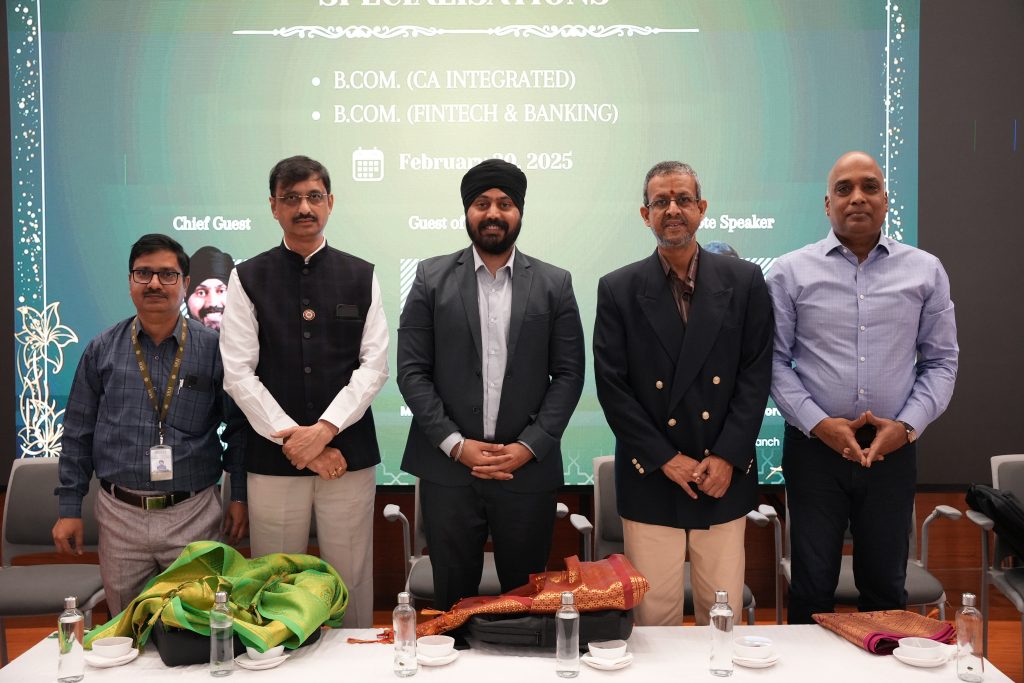
Guest of Honour Mr Bala Iyer emphasised the importance of networking and building connections among different strata of the business and economic fields as the real wealth that one must accumulate. In his keynote address, CA Ravi Kishore also underscored the significance of practical and soft skills accompanied by a mindset for continuous learning triumph over academic qualification in the real world. Both dignitaries launched the specialisations B.Com. (Fintech and Banking) and B.Com. (CA Integrated) respectively.
The event also witnessed the launch of the much-awaited two-day Business fest AMEYA’25 by the Chief Guest Mr Ruhbir Singh. AMEYA’25, the Management Mavericks’ Meet will hold numerous formal and informal events, ranging from Business Development to PR and Entrepreneurship, with a prize pool of Rs 1.75 Lakh. The fest will welcome students and participants from management colleges and universities in Vijayawada and Guntur. The event concluded with the felicitation of the esteemed dignitaries and a vote of thanks from the Head of the Commerce Department.
- Published in Commerce Current Happenings, Departmental News, News, Paari Current Happenings, paari-events
Patent on CBVR Published by Dr Jatindra Dash
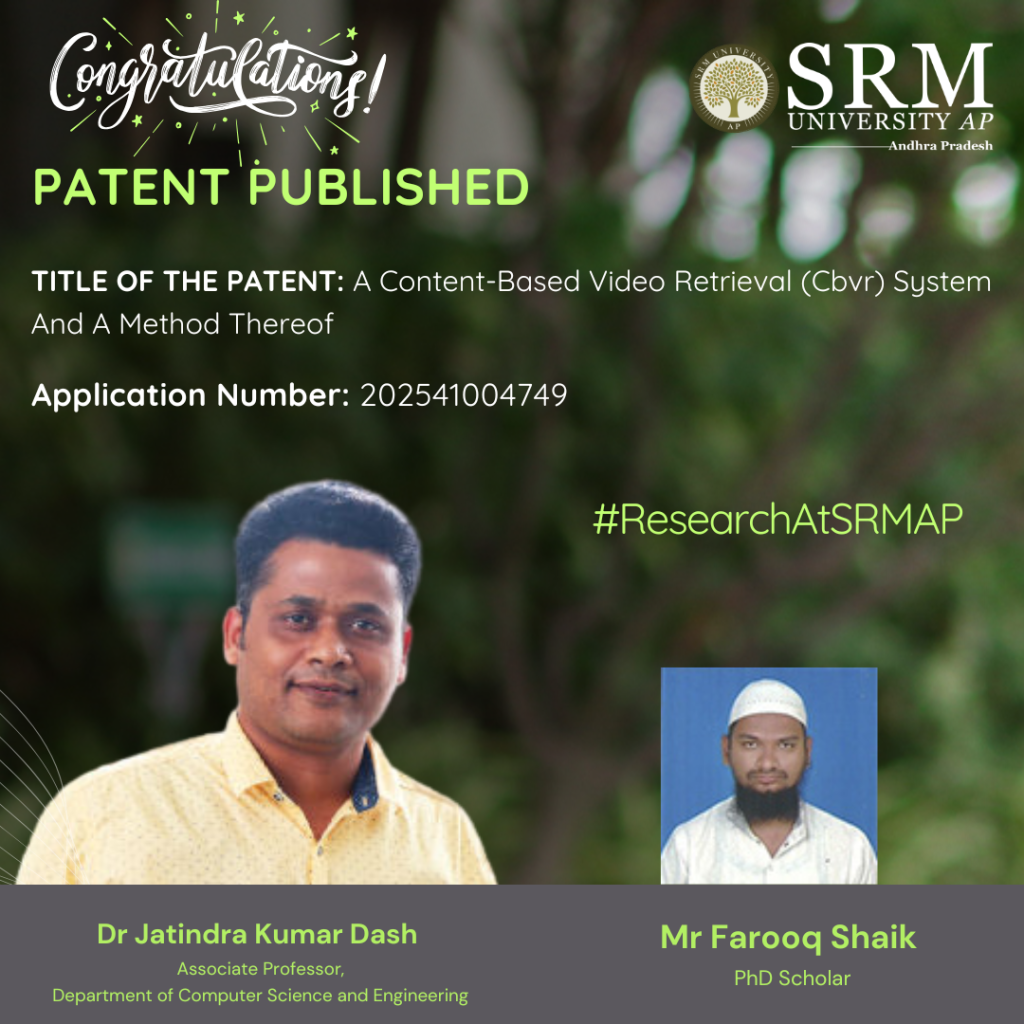 The Department of Computer Science and Engineering is delighted to announce the publication of a patent titled “A Content-Based Video Retrieval (CBVR) System and Method Thereof,” with application number 202541004749. The invention offers an efficient and accurate approach developed for content-based video retrieval by Dr Jatindra Kumar Dash, Associate Professor in the Department, along with his PhD scholar, Mr Farooq Shaik.
The Department of Computer Science and Engineering is delighted to announce the publication of a patent titled “A Content-Based Video Retrieval (CBVR) System and Method Thereof,” with application number 202541004749. The invention offers an efficient and accurate approach developed for content-based video retrieval by Dr Jatindra Kumar Dash, Associate Professor in the Department, along with his PhD scholar, Mr Farooq Shaik.
Brief Abstract:
Imagine searching for a specific scene in a movie, not by remembering its title or actors, but by describing the action itself. This is the essence of content-based video retrieval (CBVR), a technique that searches for a video based on what’s inside it, rather than relying solely on manually assigned labels. Unlike traditional methods, which can be time-consuming, error-prone, and struggle with vast datasets, CBVR offers a more efficient and accurate approach. Our proposed system leverages the strong capability of deep learning, a subset of artificial intelligence, to analyse videos and extract their key characteristics. This process occurs in two stages: offline and online. Through the first stage, important features are extracted from all videos in the dataset and stored for future use. When a user submits a query video, its features are extracted in real-time (online) and compared to the stored features of all videos. The videos with features most similar to the query, essentially those with the “closest match” are then presented to the user. To capture the full essence of a video, our system employs a two-stream neural network architecture. This innovative approach allows us to extract both temporal features, which capture the changes and motion patterns within the video (think: someone running or jumping), and spatial features, which pivot about the static visual content of each individual frame (think: the objects and scene depicted).By utilizing a pre-trained neural network called ResNet-60, our system benefits from existing knowledge and can efficiently extract meaningful features from videos. To evaluate its effectiveness, we tested our system on the UCF101 dataset, a widely used benchmark consisting of 101 categorized videos. Our approach obtained accuracy 93,7\% for top 5 retrieval and 95.95\% for top 10 retrieval. The outcomes illustrate that our approach obtains superior accuracy compared to other state-of-the-art video retrieval methods.
Explanation in Layperson’s Terms:
Most of video searching platforms relay on meta data attached to video to search and retrieve videos. For example you tube utilize video name description attached to video while uploading. How ever this approach is time consuming, error prone, and need human intervention. Our proposed CBVR system aims to retrieve videos based on content of video similarity rather than meta tags. Proposed article utilized pre trained Deep neural network particularly ResNet-50 a convolutional neural network with residual skip connections to learn video representation by employing LBP representation and Temporal map of the video.
Practical Implementation and Social Implications
The research focus on CBVR a technique that enables users to search videos based on content rather than meta tags. It has many practical implementations in various industries, such as Surveillance and security (like to search large surveillance feed particular incident), Health care and medical imagining(where doctor retrieve similar medical video for faster diagnosis), Education , Entertainment.
The research has significant social implications such as Improved accessibility to information, enhanced public safety, Advancing ai in daily lifes. Using this system in smart cities and digital systems.
Collaborations
Experiments are conducted on publicly available Dataset on DGX-1 server available at our university premises. In future we may plan to collaborate with local authorities for real time video feed to enhance proposed method capabilities.
Future Research Plans
Further in to research our plan is to propose a robust system that can be scaled and applied to all scenarios of videos may it be Medical videos, Education. Further proposed method is supervised approach, we want to explore unsupervised methods to generalize video retrieval.
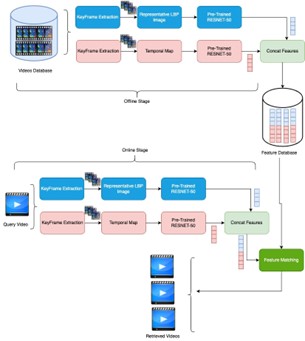
- Published in Departmental News, News, Research News
Dr Debajyoti’s Research on Improving Biofuel Production
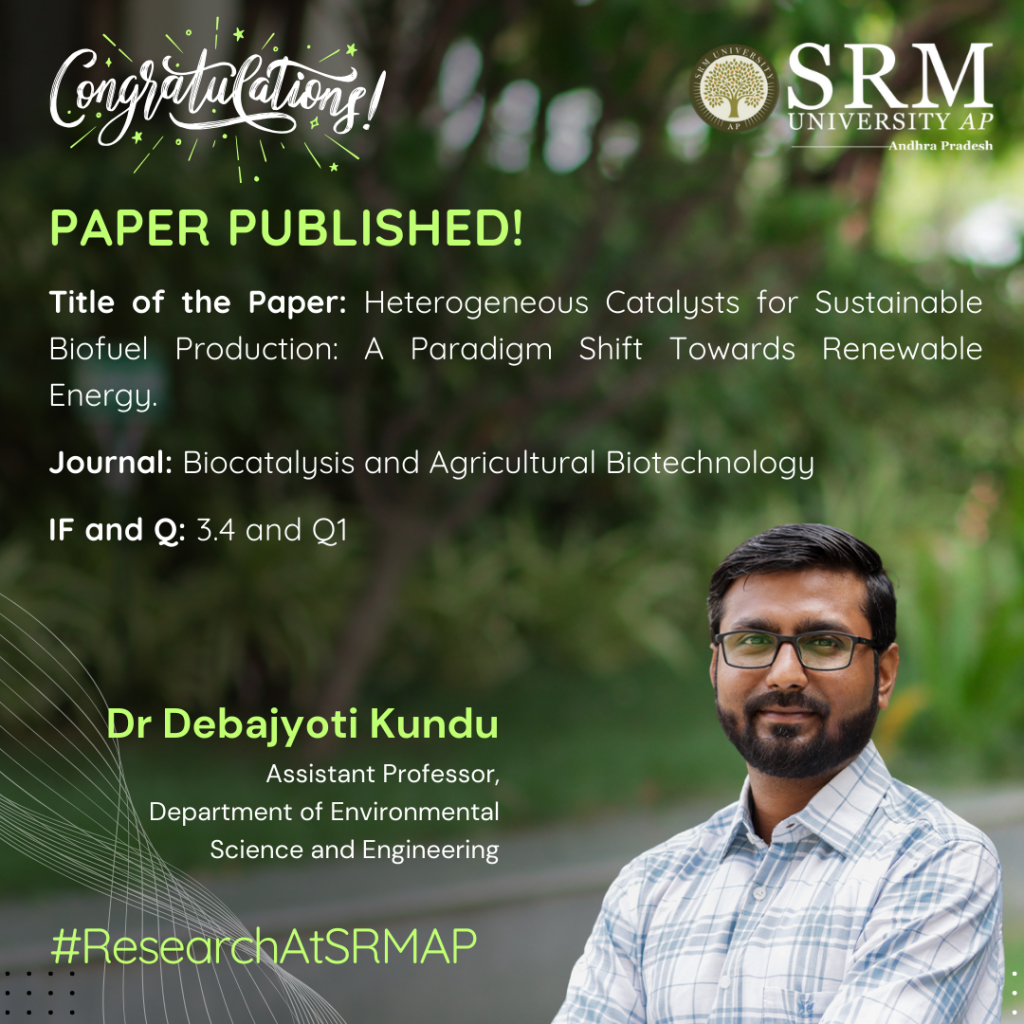 In the quest for sustainable energy solutions, Dr Debajyoti Kundu, from the Department of Environmental Science and Engineering, examines the potential of biofuels through his research paper – “Heterogeneous Catalysts for Sustainable Biofuel Production: A Paradigm Shift Towards Renewable Energy.” The paper highlights the importance of heterogeneous catalysts for improving biofuel production efficiency. The research also suggests future research to support sustainable energy practices.
In the quest for sustainable energy solutions, Dr Debajyoti Kundu, from the Department of Environmental Science and Engineering, examines the potential of biofuels through his research paper – “Heterogeneous Catalysts for Sustainable Biofuel Production: A Paradigm Shift Towards Renewable Energy.” The paper highlights the importance of heterogeneous catalysts for improving biofuel production efficiency. The research also suggests future research to support sustainable energy practices.
Brief Abstract:
This study focuses on the use of heterogeneous catalysts for sustainable biofuel production. With the growing concerns around fossil fuel depletion and environmental pollution, biofuels derived from biomass are emerging as promising alternatives. The article explores the significant role of heterogeneous catalysts in enhancing biofuel production by improving conversion efficiency, recyclability, and environmental impact. By analyzing various biomass sources, structural compositions, and the application of catalysts in bioethanol, biobutanol, biodiesel, biogas, and biohydrogen production, the study highlights recent advancements and provides recommendations for future research to drive sustainable energy solutions.
Explanation in layperson’s terms:
This research looks at how we can produce more environmentally friendly fuels from natural materials like plants and waste. Traditional fuels like oil and coal are harmful to the environment, so we are turning to biofuels made from biomass (such as plants) as a cleaner alternative. A key part of making biofuels efficiently is using special catalysts—materials that help speed up chemical reactions. The study examines how different catalysts are used to convert biomass into biofuels such as bioethanol, biodiesel, and biogas. The goal is to improve the processes, making biofuels more sustainable and accessible for the future.
Practical Implementation and Social Implications:
This research has significant implications for advancing renewable energy. The use of heterogeneous catalysts can make biofuel production more efficient and environmentally friendly, reducing reliance on fossil fuels and mitigating climate change. By optimizing biofuel production processes, we can develop cleaner energy solutions that are sustainable, carbon-neutral, and beneficial for the environment. This study also supports the ongoing shift towards renewable energy, ensuring that biofuels can contribute to reducing global energy crises and health risks associated with fossil fuel use.
Future Research Plans
Our future research will focus on the development and optimization of biocatalysts for the bioconversion of biomass into biofuels. We aim to enhance the efficiency and sustainability of biocatalytic processes, exploring new catalysts and reaction conditions that can improve the conversion of various biomass feedstocks into valuable biofuels. This research will contribute to advancing biofuel production technologies, with an emphasis on reducing environmental impact and improving the scalability of bioconversion processes for renewable energy solutions
- Published in Departmental News, ENVS News, News, Research News
Insights into Success in the Corporate Environment

The Department of Management organised a Guest Talk on the topic “The Commercial Real Estate Industry; Trends & Insights” on January 17, 2025. Mr Dibashish Ghosh, Senior Vice President and Country HR Head at Berkadia delivered an insightful session on the transition from Campus to Corporate. With over 18 years of extensive experience in human resources, Mr Ghosh has successfully led global organisations and Indian conglomerates, including GE and Genpact, in key leadership roles. His expertise, spanning organisational culture transformation, change leadership, and talent management, gave professional tips to MBA students by sharing real-world experiences, challenges and strategies for success in the corporate environment.
The session provided a holistic perspective, enabling students to connect theoretical knowledge with real-world applications in the Financial Services and Commercial Real Estate domains. The talk focused on enhancing Real Estate Industry awareness—the trends, challenges, and opportunities; Understanding the Key Financial Components and their integration with real estate investments; Knowledge of Asset classes and opportunities for investing in Commercial Properties; Practical insights into investment and mortgage banking; Impact of Regulatory and economic factors; Networking and mentorship; and Preparation for Corporate Roles.
- Published in Departmental News, News, Paari Current Happenings, paari-guest-lectures
Tech Wizards Claim South Zone Title at Nation Building Competition
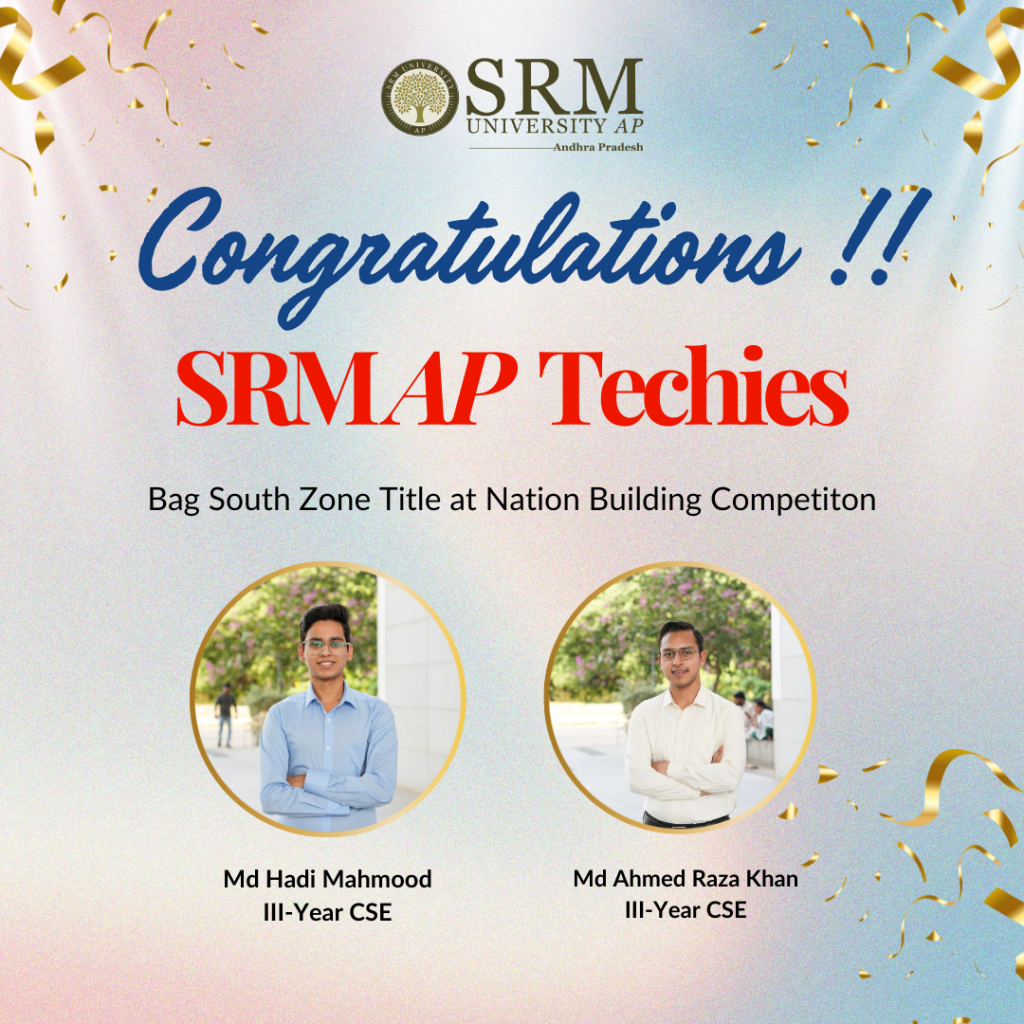
In a world where the potential of GenZs is often questioned, two of our students, Md. Hadi Mahmood and Md Ahmed Raza Khan have proven that their engagement can deliver meaningful change. These III-year BTech CSE students have showcased an inspiring display of their intellect and innovative prowess at the Nation Building Case Study Competition, an annual event that aligns with the “Viksit Bharat” initiative led by Hon’ble Prime Minister Shri. Narendra Modi, inviting college teams from across the nation to develop creative strategies aimed at transforming India into a developed country by 20247.
Here’s an excerpt of their interview:
1. What was the competition/event about?
The NationBuilding Case Study Competition is an annual event organised to inspire young college students to contribute to India’s development by addressing critical national issues. Participants engage in a 2-month-long journey involving multiple rounds, including an online quiz, presentation submissions, zonal finals, and the national finals in New Delhi. The competition is judged by a distinguished panel of experts in the given domain.
This year’s competition, NationBuilding Case Study Competition 2025, focused on the problem statement of identifying the gaps in India’s sports environment. Participants were tasked with studying the sports systems of other countries, analysing their strengths, and drafting a model to achieve India’s vision of hosting and winning 100 medals in the Olympics by 2036. This theme aimed to encourage innovative solutions to elevate India’s standing in global sports and align with the broader goal of nation-building.
2. What place did you secure?
We secured the 1st rank in the South Zone during the third round of the competition, competing against teams from multiple prestigious institutions. This achievement has advanced us to the national finals, where we will compete against the top 2 teams from each of the six zones: North, South, East, North East, West, and Central.
3. How did you find out about the competition?
We discovered this opportunity on the Unstop platform. The NationBuilding Case Study Competition is widely recognised and attracts thousands of teams annually, making it a highly sought-after event for students across India.
4. Who were your competitors
In the South Zone, we competed against 10 teams from premier institutions. The competition was intense, as participants brought innovative solutions to the table, reflecting the high level of talent and dedication among the youth.
5. Your feelings on advancing this far and future aspirations.
We are excited to have advanced to the national finals. Competing against the best teams from across the country is both a challenge and an opportunity to showcase our strategic thinking and problem-solving skills. This competition has allowed us to apply our skills & knowledge to real-world issues, which has been incredibly rewarding. We look forward to the final round and hope to contribute meaningfully to the vision of a developed India.
- Published in CSE NEWS, Departmental News, News, Students Achievements
Developing Organic Thin-Film Transistors into Biosensors

The Department of Electronics and Communication Engineering is proud to announce that Dr Durga Prakash M and his scholar Prasanthi Ms Prasanthi Lingala have their invention titled “An Organic Thin-Film Transistors (OTFTs) with Steep Subthreshold and Ultra-Low Temperature Solution Processing for Label-Free Biosensing” published in the Indian Patent Office Journal with the Application Number: 202541000088. Their research focus on developing an Organic Thin-Film Transistor (OTFT) that is able to work as a biosensor in detecting diseases or for real-time health monitoring.
Abstract
Organic Thin-Film Transistor (OTFT): The name “organic thin-film transistor” (OTFT) refers to a type of transistor that employs organic semiconductor materials in its active layer rather than the more traditional inorganic materials such as silicon. Optical thin-film transistors (OTFTs) are distinguished by their adaptability, low fabrication cost, and optimal applicability for electronic devices that are lightweight and portable. Considering their high sensitivity to changes in the surrounding environment and their compatibility with functionalised layers for the detection of biomolecules, these transistors find widespread application in the field of biosensors.
Explanation of the Research in Layperson’s Terms
Imagine a flexible electronic switch that can be bent, stretched, and used in lightweight devices—this is what an Organic Thin-Film Transistor (OTFT) does! Unlike traditional transistors made from rigid silicon, OTFTs use special organic materials, making them more adaptable for wearable sensors, flexible displays, and medical devices.
The research focuses on how these transistors can be used as biosensors, meaning they can detect tiny changes in the environment, like the presence of certain chemicals or biomolecules. This is important for medical testing, where OTFTs could help develop low-cost, highly sensitive diagnostic tools—imagine a simple patch that can detect diseases from sweat or a flexible sensor for real-time health monitoring! By improving how OTFTs interact with biological substances, the team aims to make them more accurate, efficient, and reliable for next-generation healthcare and wearable technology.

Fig.: Schematic structure of DNTT based OTFT
- Published in Departmental News, ECE NEWS, News, Research News
Theory-Experiment Dialogue on Big Bang Nucleosynthesis

The Department of Physics organised a Department Research Seminar on February 05, 2025, that offered a theoretical expression on Big Bang Nucleosynthesis. The seminar, which unravelled as a theory-experiment dialogue, also delved into interesting topics like Quantum Field Theory and General Relativity. Dr Martin Schaefer, nuclear physicist from the Department of Theoretical Physics Nuclear Physics Institute, Czech Academy of Sciences was the keynote speaker of the session.
The key idea of this session was to understand the means of the Big Bang and the Standard Model Lagrangian Method. Dr Schaefer discussed the nuclear reactions that formed the early universe and had an interaction session with the participating students and scholars.
The workshop was based on ‘Big Bang to Now: Exploring the Origins of the Universe’ with Nuclear Processes during Big Bang Nucleosynthesis. It focused on understanding the universe’s origins and the nuclear processes responsible for its birth during Big Bang nucleosynthesis.
Big Bang Nucleosynthesis (BBN) refers to the process that occurred roughly 10 seconds after the Big Bang when the temperature of the universe dropped enough for atomic nuclei to form. This has led to the creation of stable elements such as helium and lithium isotopes, which played a crucial role in the evolution of the universe. The specific abundance of these elements provides observable imprints in the universe today, helping scientists validate theories like the Hot Big Bang Model and the Standard Model of particle physics.
The study of BBN allows scientists to understand the fundamental forces and nuclear interactions that governed the early universe. Dr Martine Schaefer provided insightful and educative information by helping scientists test the hot Big Bang theory. The session proved to be an incredible platform for scholars, students, and faculty to collaborate and discuss theoretical and experimental physics.
- Published in Departmental News, News, Physics News
MoU with SHRI Opens New Pathways in Medicine
In an effort towards enhancing academic and research capabilities, SRM University-AP and Samishta Hospital and Research Institute (SHRI) formalised an understanding on scientific cooperation in biological sciences and other areas of mutual interest. The MoU signing ceremony that took place at SRM University-AP and was signed by Dr R Premkumar, Registrar- SRM University-AP and Dr Kalyan Chakravarthy, Managing Director-Samistha Hospital and Research Institute, Guntur in the presence of Dr Sandeep and Dr Ravi Teja, Dr Varun, Dr Ramakrishna, Dr Gnana Prakash Doctors from SHRI and Prof. C V Tomy, Dean-School of Engineering and Sciences; Prof. Ranjit Thapa, Dean-Research; Prof. Jayaseelan Murugaiyan, Associate Dean-Sciences (Admission Outreach and Research Collaborations); Assistant Professors at the Department of Biological Sciences-Dr Sutharsan Govindarajan, Dr Anil K Suresh, Dr Prateek Gupta among others.
The MoU will open pathways for collaborative opportunities in research and academics, fostering joint research projects and funding possibilities while also emphasising the importance of skill development through seminars organised by both the institutions.
Registrar Dr R Premkumar highlighted the significance of this partnership and the potential outcomes of the joint venture. Dr Sutharsan Govindarajan thanked the team from Samistha Hospitals and Research Centre for joining hands and taking the phase therapy from bench to bedside. This MoU between the two institutes of eminence aims to create a dynamic environment for innovative research that will benefit not just our institutions but also the society in general.
- Published in Biology News, Departmental News, MoU, News
Field Trip to Hyderabad: A Journey of Education, Culture, and Adventure
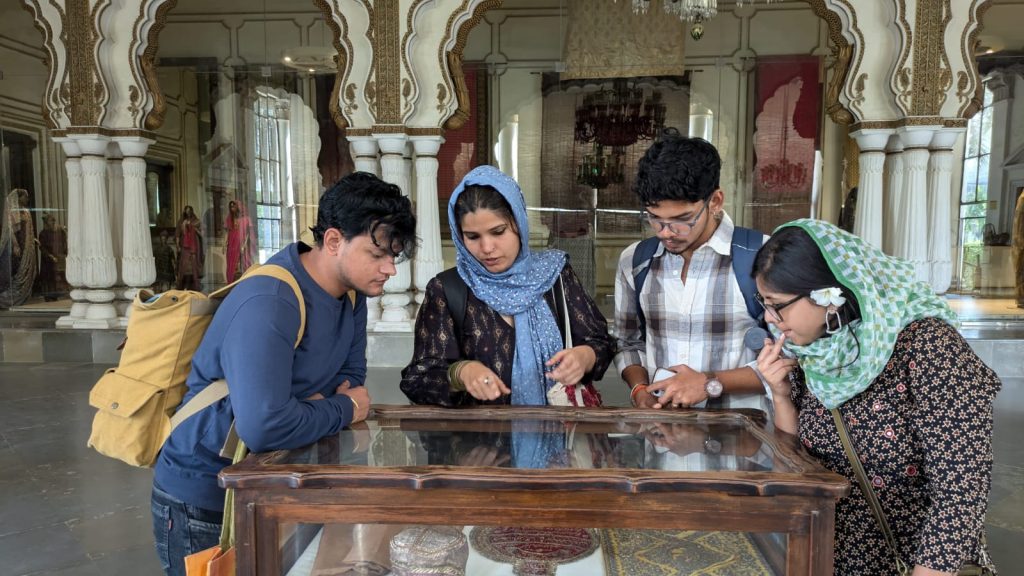
The 5th Semester B.A. History students went on a field trip to Hyderabad as part of their courses ‘Medieval India’ and the ‘Eighteenth Century in Indian History’. Dr Aqsa Agha, Course Coordinator, and Dr Manaswini Sen led the study group to explore the city’s historical and cultural significance, enhancing their learning outside the classroom for the two courses.
The group visited Charminar, exploring the iconic monument and its surrounding bazaars, Golconda Fort, discussing its history and architecture with a Heritage Walk Practitioner from Hyderabad, and finally the Qutb Shahi Tombs and gardens, a standing testament of Indo-Persian architectural excellence.
The field trip provided students with a refined exposure to the diverse culture and history of Hyderabad and the historical context of the evolution of the culture of the city. The students had a wonderful chance to visit the important historical monuments and urban morphology that mark the period of study in the courses on Medieval and Eighteenth-century Indian History.
The field trip fostered a deep understanding of the respective courses, inspiring students to explore beyond books and classrooms.
- Published in Departmental News, History Current Happenings, History News, News


